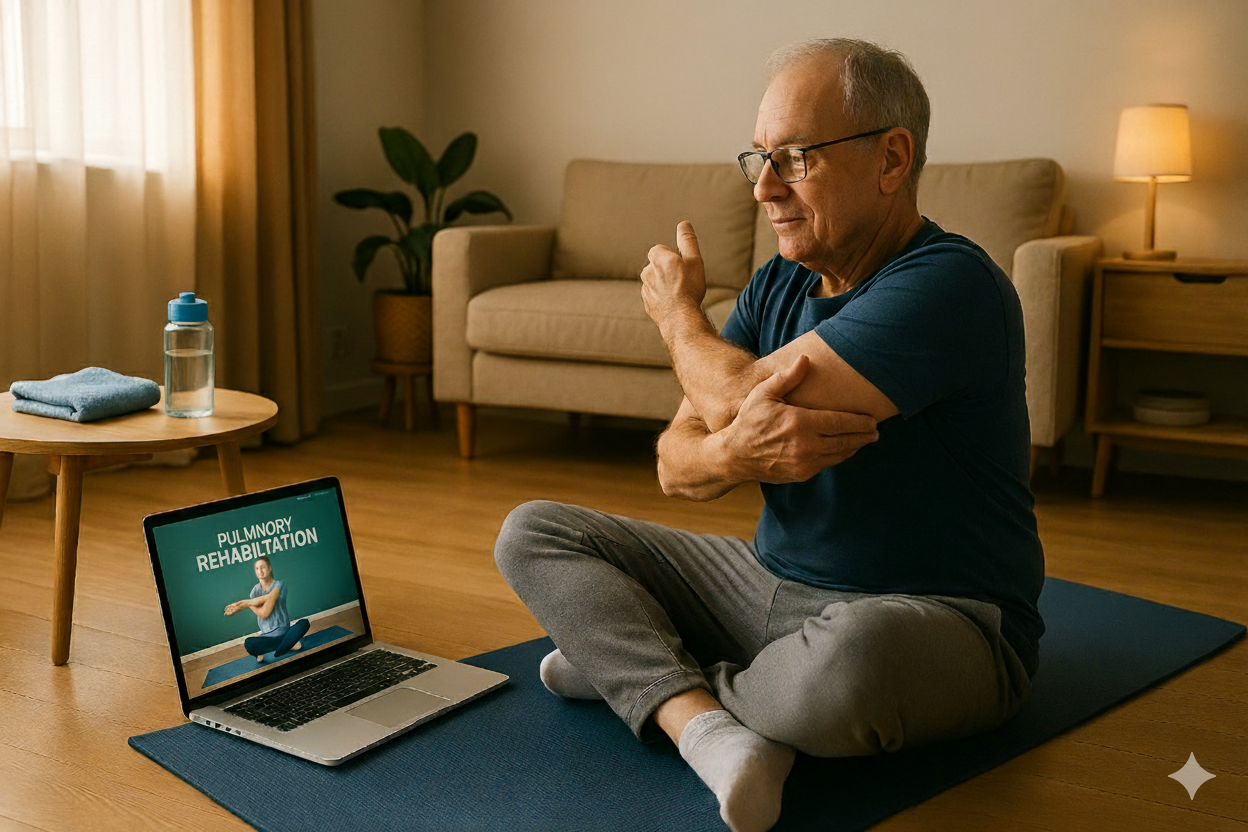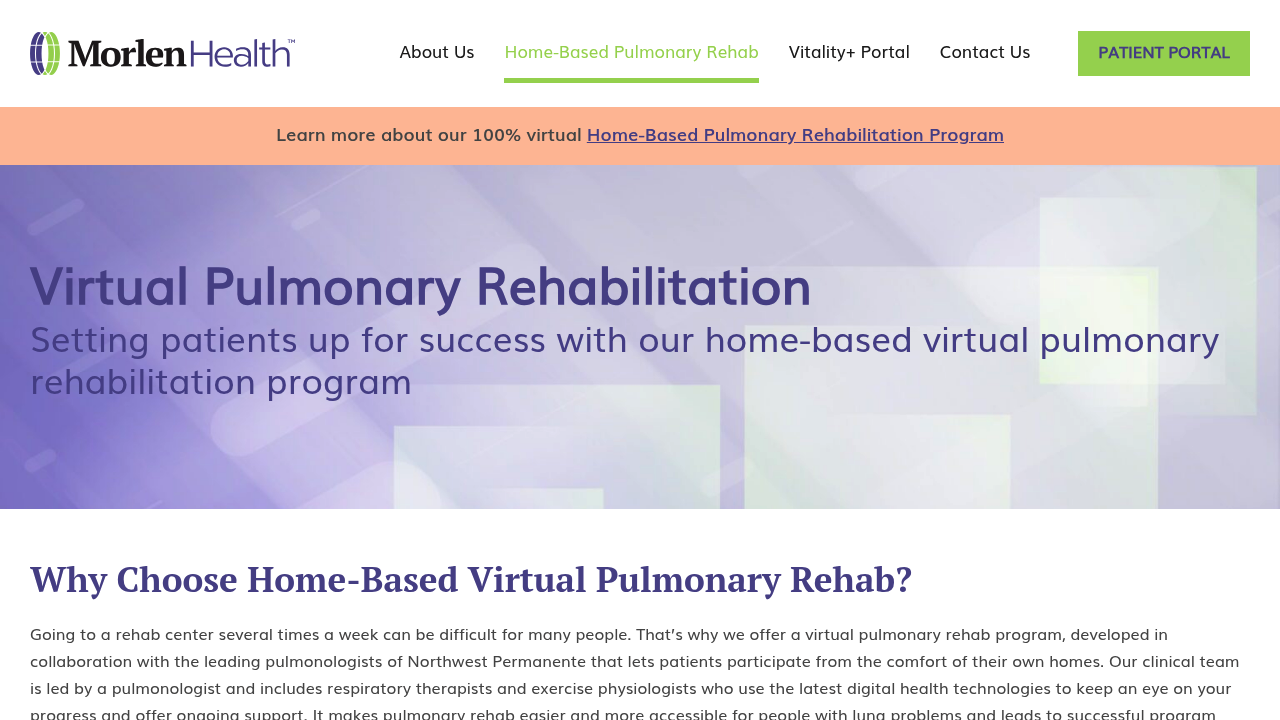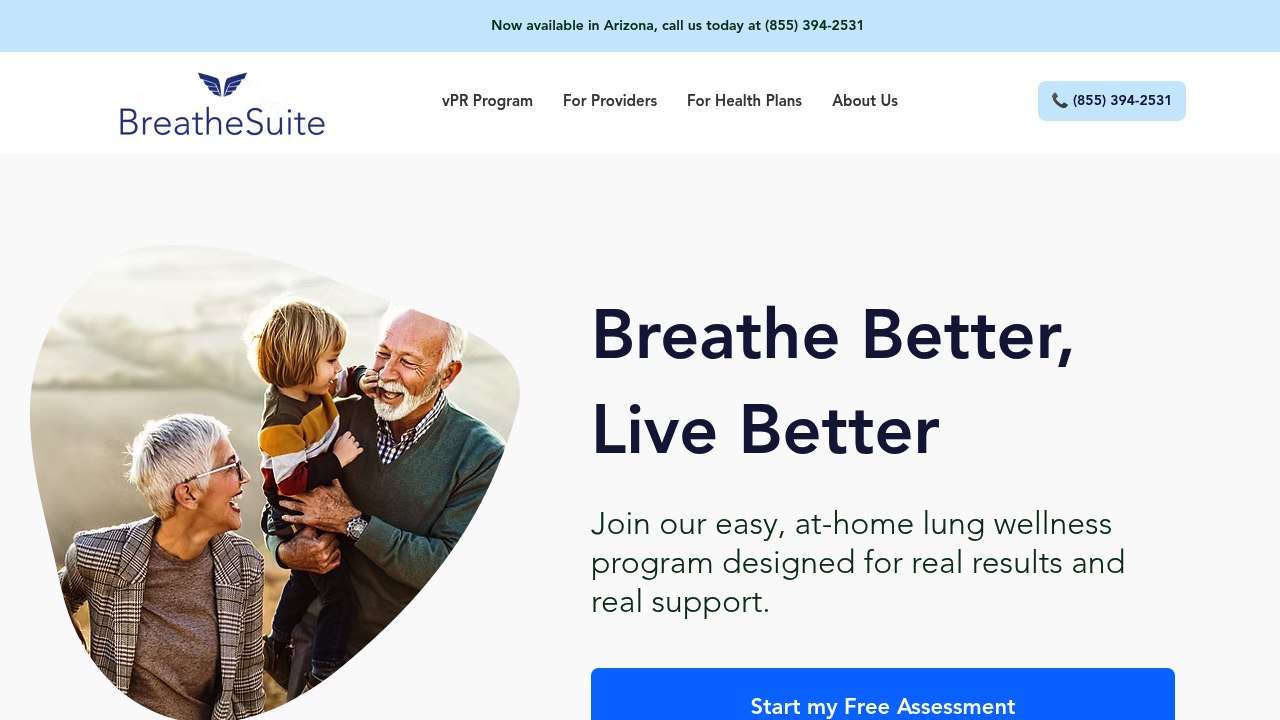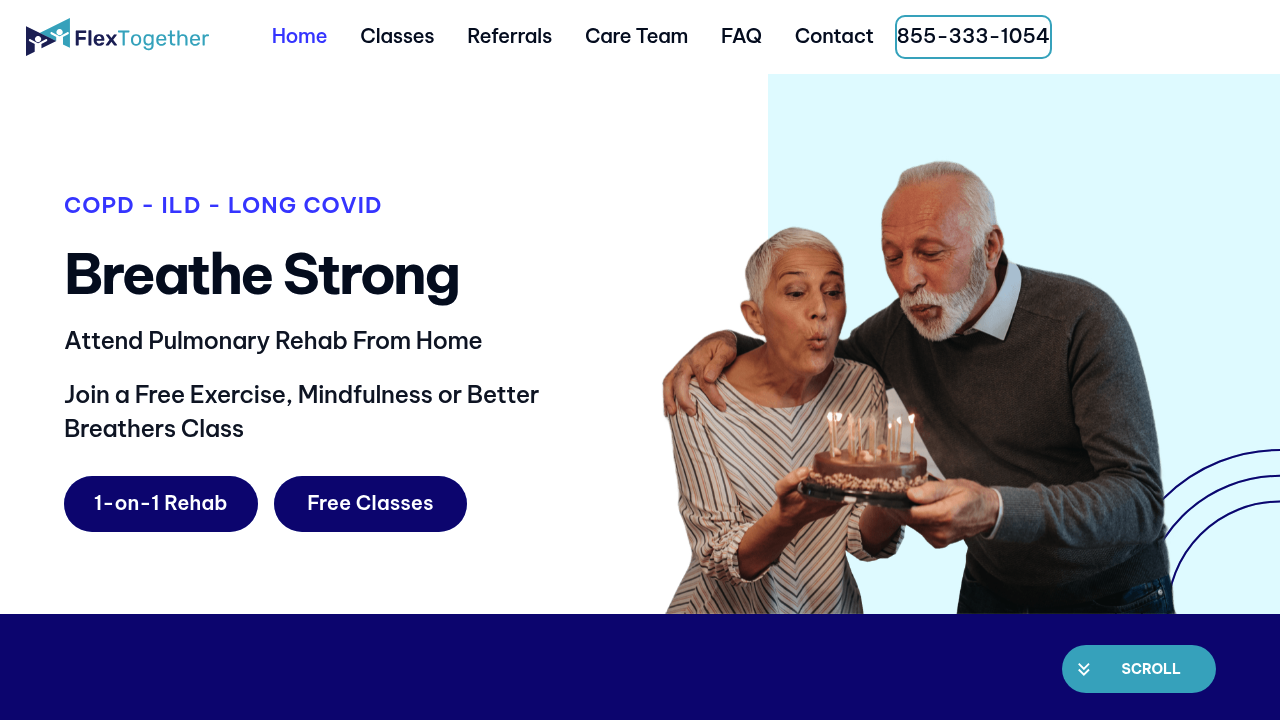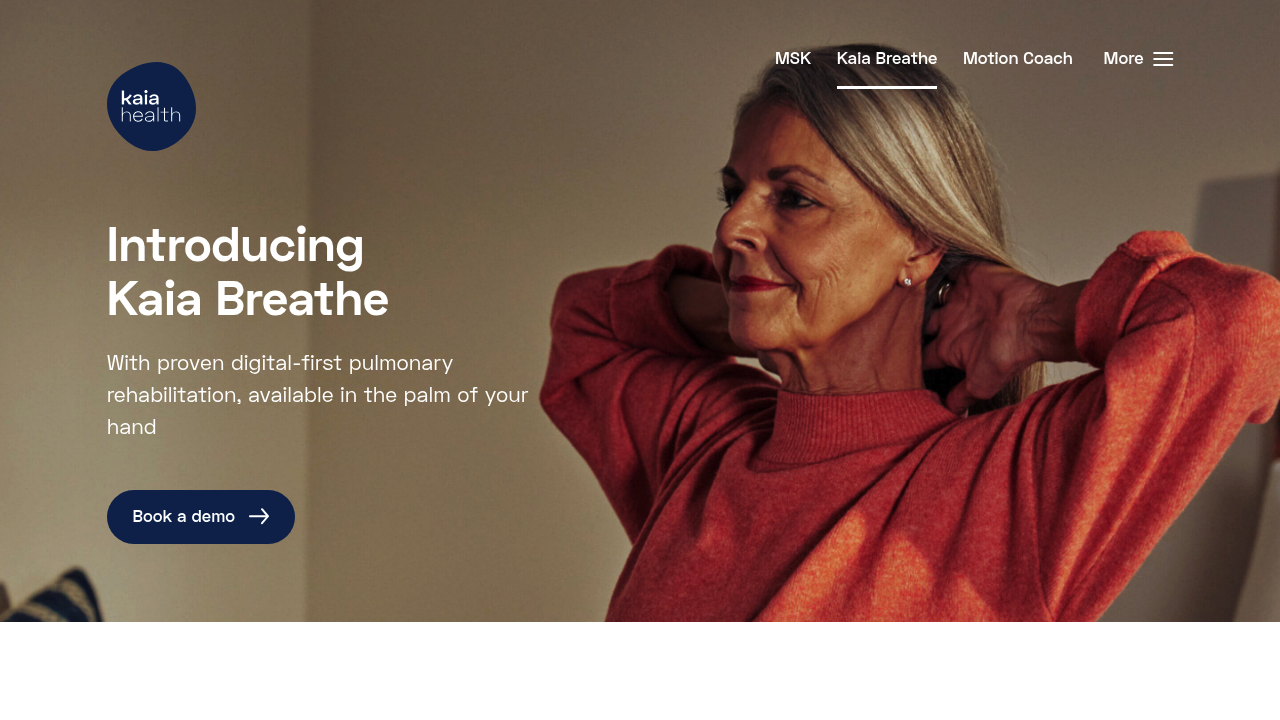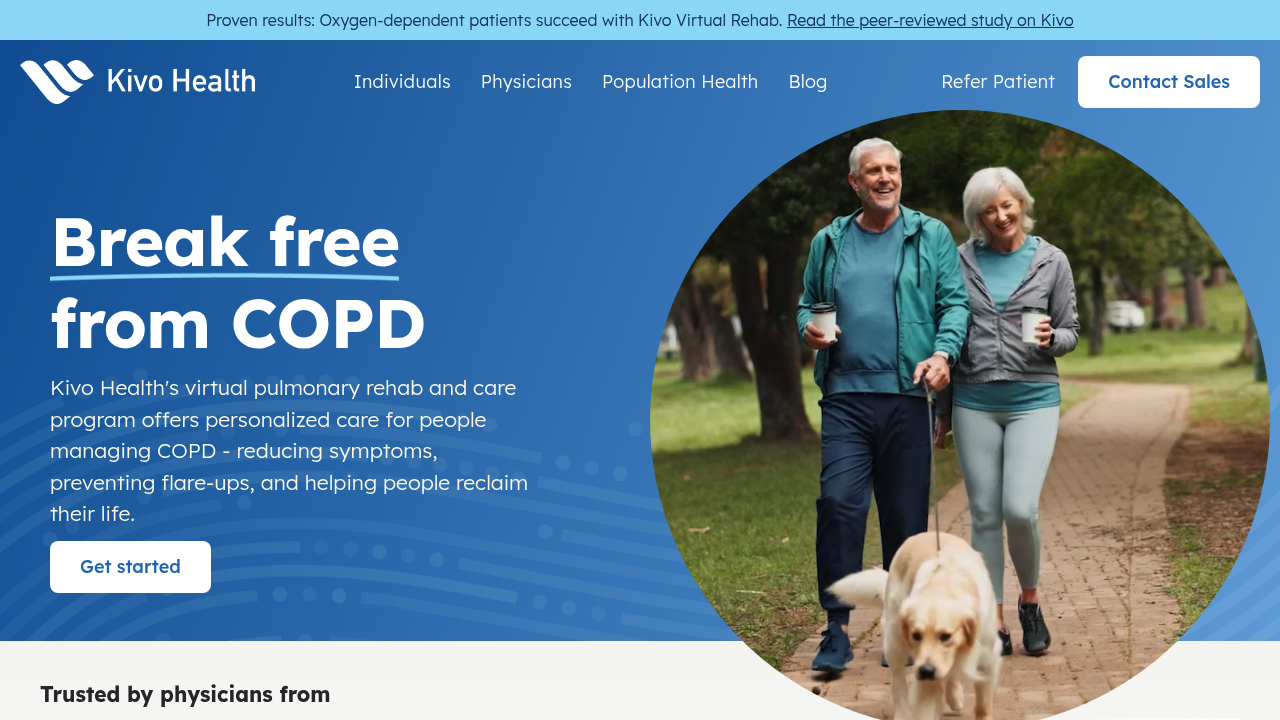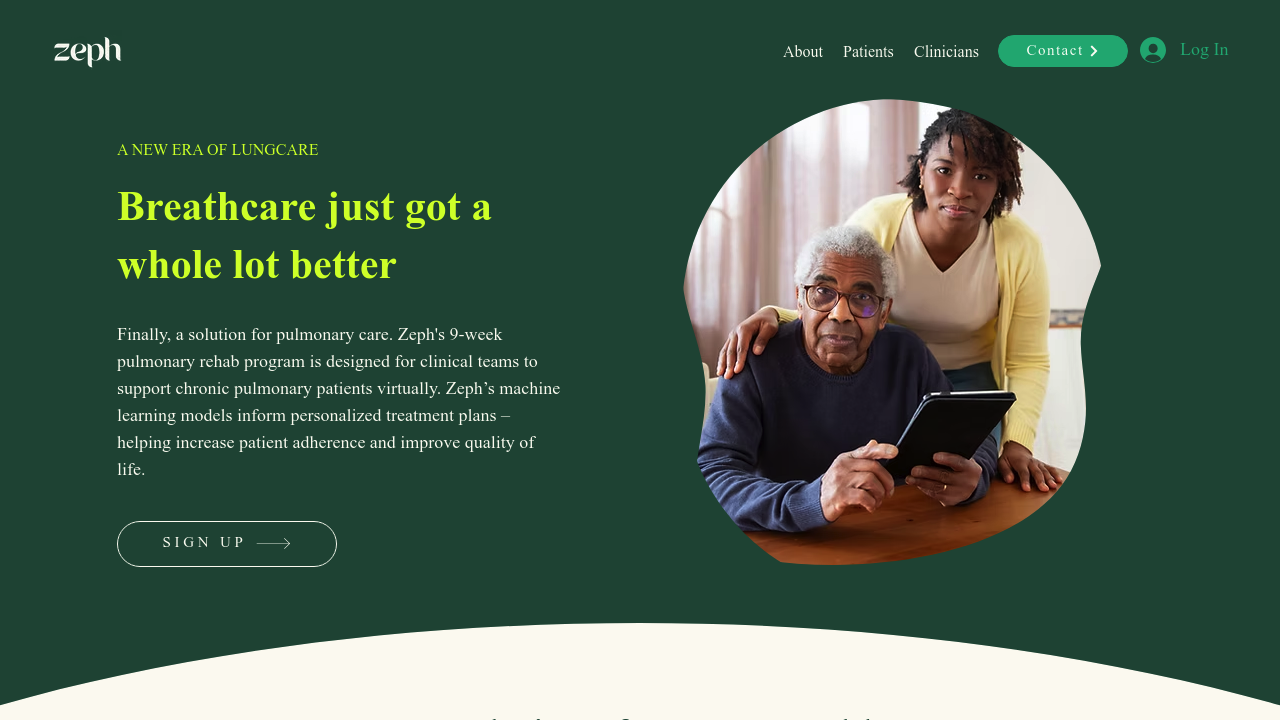Living with COPD? Virtual pulmonary rehabilitation (PR) makes managing your condition easier by bringing therapy into your home. Here's what you need to know:
-
What It Is: Virtual PR uses video calls, apps, and remote devices to guide exercises, monitor vitals, and provide education.
-
Why It Matters: It’s as effective as in-person rehab, but more accessible - ideal for those with mobility or travel challenges.
-
Key Benefits:
-
Improves breathlessness and stamina.
-
Reduces hospital visits by 65%.
-
90% completion rates vs. 58% for in-person programs.
-
-
How It Works: Programs include breathing exercises, fitness routines, mental health support, and personalized plans.
-
Safety: Monitored via pulse oximeters and smart devices, with 99% of participants completing programs without issues.
Quick Start: Get a doctor’s referral, set up basic devices like a pulse oximeter, and join a program like Morlen Health or Kivo Health.
Why Choose Virtual PR? It’s flexible, effective, and designed to fit your life. Let’s dive into how it works and how to begin.
Key Components of At-Home Virtual Pulmonary Rehabilitation
Core Features of Virtual PR Programs
At-home virtual pulmonary rehabilitation (PR) programs focus on five main areas: structured exercise routines, patient education, breathing retraining, mental health support, and nutritional guidance. Together, these components provide a well-rounded approach to managing chronic respiratory conditions. Respiratory therapists lead exercise sessions through video calls, tailoring activities to match each patient’s fitness level and oxygen needs.
These sessions typically last between 30 and 60 minutes, focusing on building endurance, strength, and flexibility. Throughout the workout, vital signs are continuously monitored to ensure safety and progress at a comfortable pace.
"Respiratory therapists are the main providers of care in our program" - Stephen Wehrman, RRT, RPFT, FAARC, RT for the virtual PR program at Morlen Health [4].
Educational sessions are another cornerstone of these programs. Patients learn practical skills, like proper inhaler use, recognizing changes in symptoms, conserving energy, and knowing when to seek medical help. Many programs also provide interactive resources that participants can explore between sessions, reinforcing what they’ve learned.
Breathing retraining techniques are designed to help patients use their respiratory muscles more effectively. Common methods include pursed-lip breathing, diaphragmatic breathing, and paced breathing exercises. These techniques can ease shortness of breath during daily activities and improve overall lung function.
Mental health support is also a key element, addressing issues like anxiety and depression that often accompany chronic respiratory conditions. Programs may include counseling, stress management techniques, and peer support groups to help patients cope emotionally.
To enhance these features, many programs incorporate devices that monitor progress and ensure safety.
Device Integration for Progress Tracking
The integration of connected devices is a significant aspect of virtual PR programs, enabling therapists to monitor patients in real time and adjust treatment as needed.
Pulse oximeters play a critical role, measuring heart rate and oxygen saturation (SpO₂) levels during exercise sessions [5]. Many programs supply Bluetooth-enabled oximeters that sync with phone apps, instantly sharing data with care teams [3]. In some cases, patients receive oximeters and pulse monitors that connect to tablets for seamless tracking [3].
Other devices, like wearable fitness trackers, monitor daily activity, including steps taken, distance covered, and sleep patterns. Smart inhalers and medication trackers ensure patients stick to their treatment plans. For example, a patient might begin with a daily walking goal of 0.25 miles and gradually work up to 1 mile as their stamina improves. This progression is particularly important, as studies show that only 10% of patients using metered dose inhalers follow all necessary steps correctly [7].
Some programs go a step further by providing comprehensive kits. These packages often include tablets, exercise bands, and pulse oximeters, ensuring patients have the tools they need, regardless of their access to technology.
| Device Type | Primary Function | Typical Measurements |
|---|---|---|
| Pulse Oximeter | Monitor oxygen levels and heart rate | SpO₂ percentage, beats per minute |
| Fitness Tracker | Track daily activity and sleep | Steps, miles walked, hours of sleep |
| Smart Scale | Monitor weight changes | Pounds, BMI calculations |
| Thermometer | Track body temperature | Degrees Fahrenheit |
While these devices provide valuable insights, strict safety protocols ensure patients can exercise confidently and effectively.
Safety Guidelines for At-Home PR
Safety is a top priority in virtual pulmonary rehabilitation, especially since patients exercise without direct, in-person supervision. Comprehensive protocols help minimize risks and ensure a safe experience.
Before starting a session, patients use a pulse oximeter to confirm their oxygen saturation is within a safe range. If levels are too low, exercise should be postponed. During sessions, patients are instructed to monitor their heart rate and oxygen levels continuously. They’re also taught to recognize warning signs - such as severe shortness of breath, extreme fatigue, dizziness, nausea, chest pain, or an irregular heartbeat - and to stop exercising immediately if these occur [8].
Recovery guidelines are equally important. After exercise, patients monitor how long it takes for their heart rate and breathing to return to normal, which typically happens within 5–10 minutes for appropriately paced workouts.
Vancouver Coastal Health has developed detailed safety protocols for virtual PR programs, including pre- and post-exercise checklists to ensure sessions run smoothly [5]. Research indicates that 99% of participants in these programs complete their sessions without any adverse effects [2].
Proper training on device usage is another critical safety measure. Patients are taught how to use pulse oximeters correctly, including proper finger placement, staying still during readings, and identifying factors like cold hands or nail polish that might interfere with accuracy [5].
Some programs even incorporate artificial intelligence tools to add an extra layer of security. These algorithms compare patient data to baseline metrics, alerting care teams to potential issues before they become serious [5].
How to Access and Join Virtual PR Programs
Virtual PR Programs At-A-Glance
| Program | Duration | Key Differentiator | States Available | Medicare Coverage | Contact |
|---|---|---|---|---|---|
| Kivo Health | 8 weeks | Live respiratory therapists with real-time monitoring | Nationwide | ✅ Yes | Physician referral required |
| Zeph Breath | 9 weeks | AI-powered personalization + mental health support | Available through healthcare providers | ✅ Yes | Contact healthcare provider |
| Kaia Breathe | Ongoing | Post-rehab maintenance with AI motion analysis | Smartphone app | Varies by plan | Download app |
| FlexTogether | 12 months | Chair-accessible exercises for mobility limitations | CA, FL, VT | ✅ Yes | (855) 333-1054 |
| BreatheSuite | 12 weeks | Complete equipment kit + dual PT/RT specialists | Arizona only | ✅ Yes | (855) 394-2531 |
| Morlen Health | 8-12 weeks | Kaiser Permanente physicians + $6.55M tech investment | Expanding from Oregon | ✅ Yes | (503) 917-0685 |
Enrolling in a Virtual PR Program
The first step to joining a virtual pulmonary rehabilitation (PR) program is obtaining a referral from your physician. Since most programs require medical clearance, your healthcare provider will assess whether virtual PR is suitable for your condition and overall health.
Programs like Morlen Health and Kivo Health have structured enrollment processes. These typically include intake assessments, program orientations, and the option to start immediately after a provider referral. Referrals can be submitted through online forms, fax, or other documentation provided by your healthcare provider [10]. Some programs even allow for more flexible enrollment, letting patients begin while awaiting provider referrals [11].
During the initial assessment, expect a detailed evaluation of your needs, fitness level, and rehabilitation goals. This consultation is your chance to discuss your lifestyle, health challenges, and any specific concerns.
"Morlen Health always conducts a thorough assessment to determine the specific needs and goals of the patient before initiating the rehabilitation program." [10]
This personalized approach reflects the commitment to accessible and tailored COPD management.
Technology Requirements for Virtual PR
Once enrolled, you'll need to meet the technical requirements to participate effectively. A computer, laptop, or tablet with video conferencing capabilities and a reliable internet connection is essential for real-time interactions [5].
For example, Vancouver Coastal Health uses Zoom for exercise training and educational sessions, ensuring a user-friendly experience. Connected monitoring devices are also a key component. The Vancouver General Hospital PR Team incorporates smart devices from Agartee Technology Inc. to track health metrics in real time. These devices automatically send data to your care team, enhancing the program's effectiveness [5].
| Device Type | Function | Usage Instructions |
|---|---|---|
| Modem | Transmits data to the care team | Keep plugged in at home |
| Wristband | Tracks activity and sleep quality | Wear on your wrist continuously |
| Pulse Oximeter | Monitors heart rate and oxygen levels | Use daily and during exercise |
| Medication Tracker | Logs inhaler usage timing | Attach to inhaler and use normally |
| Weight Scale | Tracks weight changes | Use at least once daily |
| Thermometer | Measures body temperature | Use at least once daily |
Virtual PR platforms are designed with U.S. users in mind, displaying information in familiar formats like MM/DD/YYYY for dates, Fahrenheit for temperatures, and pounds for weight. Exercise distances are often measured in miles, simplifying the experience for American participants.
Before starting, take time to familiarize yourself with the program's technology. Many offer tutorials or orientation sessions to help you navigate the platform confidently, so technical hiccups don’t interrupt your rehabilitation [9].
🔍 Ready to Find Your Virtual Pulmonary Rehab Program?
We've reviewed 6 leading virtual pulmonary rehabilitation programs to help you find the perfect fit for your needs, location, and insurance coverage.
-
✅ All Medicare-covered options
-
✅ Programs for every mobility level
-
✅ Nationwide and state-specific choices
-
✅ Live therapists to AI-powered personalization
Explore All Virtual PR Programs in Our Directory → COPD Essentials
Each program has been thoroughly researched and reviewed by our team to help you make the best choice for your respiratory health journey.
Tips for Getting the Most from Your PR Experience
Once you're set up, a few practical steps can help you make the most of your virtual PR program. Create a dedicated, distraction-free space for your sessions. Ensure there’s enough room to move comfortably, good lighting, and keep your equipment and program materials within reach [14].
Virtual PR programs often have higher completion rates compared to in-person options, thanks to their convenience and accessibility [13]. To maximize your results, attend sessions consistently and follow the exercises and strategies recommended by your healthcare team [10].
Take advantage of all the program resources. Many virtual PR programs combine one-on-one therapy with group education sessions [10]. Group classes offer valuable peer support and shared learning opportunities, while individual sessions focus on your specific needs and goals.
Communication is key. Share any concerns or changes in how you’re feeling with your healthcare team right away. Your feedback helps tailor the program to your evolving needs.
"The most beneficial part of pulmonary rehabilitation was gaining the knowledge to understand what was happening to me and being able to control my breathing. This in turn assisted in controlling periods of depression and anxiety as well as accepting I have a serious health condition." – Eric, Bundaberg, lives with COPD [15]
Explore different exercises within the program to find what you enjoy most. Options often include strength training with resistance bands, breathing exercises, or walking routines. Understanding the purpose of each exercise can help build your confidence and ensure you feel secure throughout the program.
"Virtual pulmonary rehabilitation allows for increased access to these programs, which benefit people with COPD, regardless of their supplemental oxygen use... Our findings demonstrate the need to increase use of virtual pulmonary rehabilitation programs to help improve the quality of life for people with COPD. By evaluating each patient's situation and incorporating virtually accessible programs, we can offer more individualized care for patients." – Russell Buhr, MD, PhD, Pulmonologist at the University of California, Los Angeles [1]
Effectiveness and Safety of Virtual Pulmonary Rehabilitation
Clinical Benefits of Virtual PR
Virtual pulmonary rehabilitation (PR) has shown promising results in improving health outcomes for individuals with COPD. Research highlights improvements in exercise capacity, reduced breathlessness, and enhanced overall quality of life for patients managing their condition from home.
For example, a study involving 167 COPD patients enrolled in Kivo Health's virtual PR program reported significant improvements in measures like the COPD Assessment Test (CAT), modified Medical Research Council Dyspnea Scale (mMRC), Patient Health Questionnaire-9 (PHQ-9), and sit-to-stand test. These changes exceeded minimum clinically important difference (MCID) thresholds, signaling meaningful benefits in daily life. Notably, these positive outcomes were consistent regardless of whether patients required supplemental oxygen.
A broader meta-analysis further supported these findings, showing that virtual PR increased exercise capacity by 22.88 points on standardized scales and improved quality of life scores by 3.23 points on the CAT. Improvements were also noted in dyspnea scores and lung function, with forced expiratory volume increasing by 6.30 points. Beyond physical health, virtual PR had a positive impact on mental well-being, with reductions in anxiety and depression and better cognitive function - surpassing clinical significance thresholds.
These results not only highlight the physical and psychological benefits but also contribute to high levels of patient satisfaction and adherence.
Patient Satisfaction and Program Adherence
The success of virtual PR isn’t just about clinical outcomes - it’s also reflected in how well patients stick to the programs and their overall satisfaction. Virtual PR has been shown to achieve higher adherence rates compared to traditional in-person programs. For instance, the Kivo Health study reported a median attendance rate of 88%, while telerehabilitation programs achieved a 90% completion rate, compared to just 58% for center-based programs.
Patients also report high satisfaction levels. In one survey, 91% of participants strongly agreed that peer coaches were effective in answering questions and motivating them to stay active in a virtual setting. While one study noted that face-to-face sessions had a higher attendance rate (72%) compared to online sessions (62%) [16], virtual programs tend to have fewer dropouts, leading to better overall completion rates.
Safety is another key factor in patient confidence. In the Kivo Health study, only 1% of participants experienced adverse events. Another study reported just one mild event (hypoglycemia) across all participants, demonstrating that virtual PR can be conducted safely with appropriate monitoring and support.
Virtual PR vs. In-Person PR: Pros and Cons
When choosing between virtual and in-person pulmonary rehabilitation, understanding the benefits and drawbacks of each approach can help patients make informed decisions. Here’s a quick comparison:
| Aspect | Virtual PR Advantages | Virtual PR Disadvantages | In-Person PR Advantages | In-Person PR Disadvantages |
|---|---|---|---|---|
| Accessibility | No travel required; available anywhere | Requires reliable internet and tech | Hands-on guidance | Limited by location |
| Completion Rates | 90% program completion | Potential for lower session attendance | Face-to-face motivation | 58% program completion |
| Cost | Lower overall costs; no travel expenses | Initial tech setup costs | Often covered by insurance | Travel and time costs |
| Flexibility | Schedule around personal needs | Requires self-discipline | Structured schedule | Fixed appointment times |
| Safety | Low adverse event rate (99% safe) | Limited immediate emergency response | Immediate medical support | Higher dropout risk for health issues |
| Social Support | Online peer groups, digital coaching | Less direct interaction | In-person connections | May be tough for socially anxious individuals |
Virtual PR addresses challenges like transportation, weather, and scheduling conflicts, making it especially helpful for patients in rural areas, those with mobility issues, or those managing multiple health conditions.
Both formats - virtual and in-person - deliver comparable results in improving exercise capacity, quality of life, and symptom management. However, virtual PR often proves more cost-effective by eliminating travel expenses and reducing time away from work. While in-person programs provide immediate medical support during emergencies, virtual programs rely on real-time monitoring and clear safety protocols to ensure patient well-being.
Social support is another important factor, with virtual programs offering online peer groups, video sessions, and digital coaching, while in-person programs provide direct interaction and group exercises. Ultimately, the choice between virtual and in-person PR will depend on individual circumstances and preferences, but virtual PR has proven to be a practical and effective option for managing COPD at home.
The 8 Best Pulmonary Rehab Exercises For Home
sbb-itb-3e96dba
Tools and Devices to Support At-Home COPD Management
Technology has made managing COPD at home more convenient and effective. From virtual pulmonary rehabilitation (PR) to specialized tools, these advancements aim to enhance daily living for those with COPD.
Key Devices for Virtual PR
The right tools can make a world of difference for at-home pulmonary rehabilitation. Some essential devices include portable oxygen concentrators, nebulizers, pulse oximeters, PEP devices, and mobility aids - all working together to support your daily health needs [18].
-
Pulse oximeters: These devices provide real-time feedback on your oxygen levels during exercise. If your readings drop below 90%, it’s crucial to seek medical attention [23]. A study involving 126 COPD patients using monitoring devices for over a year reported a 65% reduction in all-cause hospitalizations and a 63.6% decrease in cardiopulmonary-related hospitalizations [23].
-
Spirometers: These measure lung function by tracking how much and how quickly you inhale and exhale [21][23]. Incentive spirometers, in particular, guide slow, deep breathing exercises to expand lung capacity and prevent complications. Research shows that short-term use of these devices can improve respiratory function and strengthen the diaphragm [22].
-
Portable oxygen concentrators: These devices offer mobility and freedom compared to traditional oxygen tanks, allowing you to stay active while maintaining oxygen therapy [18]. They integrate seamlessly with virtual rehabilitation programs to support consistent oxygen delivery during exercise.
-
Wearable fitness trackers: These encourage physical activity and monitor sleep patterns. They’re especially helpful for sticking to treatment plans by setting achievable step goals. Studies show an 88.6% adherence rate to an 8-hour daily wear requirement for COPD remote monitoring [23].
-
Digital platforms: Apps like myCOPD provide online pulmonary rehabilitation classes, expert education, and inhaler technique training. They address a major challenge - 90% of COPD patients struggle with proper inhaler use. Impressively, the app has corrected 98% of inhaler errors and delivered outcomes comparable to in-person rehab classes [19]. Another platform, Datos Health, integrates connected devices to monitor oxygen levels and activity in real time while offering automated self-care tools and personalized virtual PR programs [17].
When choosing tools, it’s important to evaluate your specific needs and abilities.
How to Choose the Right Tools for Your Needs
Selecting the right devices starts with understanding your personal health needs and physical abilities. Factors like cognitive function, strength, and dexterity play a big role in determining which tools will work best for you [26].
-
Inspiratory flow capacity: If you have low inspiratory flow, pressurized metered-dose inhalers (pMDIs) or soft mist inhalers (SMIs) may be easier to use. Dry powder inhalers (DPIs), on the other hand, require a stronger inspiratory effort. Interestingly, many patients find DPIs simpler to operate than pMDIs [29][30].
-
Cost and convenience: These are key to long-term adherence. If you require multiple inhaled medications, this could influence your choice of device [26]. For oxygen therapy, consider whether you need support for long-term, ambulatory, nocturnal, short-burst, or palliative purposes - each has specific device requirements [28].
-
Oxygen delivery needs: Ensure the oxygen flow rate and FiO₂ levels meet your inspiratory requirements. Medicare covers home oxygen therapy if your resting PaO₂ is below 55 mm Hg or SaO₂ is under 88% [27].
-
Lifestyle compatibility: Portable devices offer greater freedom but might have different maintenance needs compared to stationary ones. Think about your daily routine, travel habits, and comfort level with technology when choosing [18].
-
Patient preferences: Engaging in the selection process can significantly improve adherence. Research shows that involving patients in choosing inhalers tailored to their needs leads to better outcomes [25].
Once you’ve chosen the right tools, using them properly is just as important.
Using Devices Safely and Effectively
To get the most out of your devices, follow proper usage guidelines and safety precautions.
-
Oxygen therapy: Regularly monitor your oxygen levels and report readings below 90% immediately [23]. Avoid smoking, as oxygen use increases fire risk [27]. Tracking oxygen usage during sleep and exercise can help you adjust therapy as needed. Smartphone apps and device manuals can assist with monitoring and maintenance [18].
-
Incentive spirometers: Use these devices as directed by your healthcare provider, typically by taking slow, deep breaths and holding them briefly. Clean the device daily to prevent bacterial growth. If you feel dizzy or lightheaded, stop and consult your doctor [20][21][24].
-
Inhaler technique: Proper technique is crucial for effective treatment. Incorrect use is linked to a 50% higher risk of hospitalization and increased emergency visits [25]. Regular reviews and tailored advice from healthcare providers can help maintain correct usage over time [30].
-
Wearable fitness trackers: Set realistic step goals to encourage activity without feeling overwhelmed. These devices work best when integrated into a comprehensive treatment plan [23].
-
Maintenance and reliability: Follow manufacturer guidelines for cleaning, calibration, and replacement to keep devices functioning properly. Keep backup batteries for portable devices and maintain service records for warranty and insurance purposes.
Using these tools correctly and consistently can greatly improve your COPD management at home, reducing hospital visits and improving your quality of life.
Which Virtual PR Program Fits You Best?
🏠 Need chair-accessible options? → FlexTogether (CA, FL, VT)
🤖 Want AI-powered personalization? → Zeph Breath or Kaia Breathe
👥 Prefer live therapist guidance? → Kivo Health (nationwide) or BreatheSuite (AZ)
🏥 Want major medical system backing? → Morlen Health (Kaiser Permanente physicians)
📦 Need complete equipment package? → BreatheSuite (ships everything)
🎯 Looking for post-rehab maintenance? → Kaia Breathe (clinically proven)
Explore All Virtual PR Programs in Our Directory → COPD Essentials
Conclusion: Empowering COPD Patients with Virtual PR
Virtual pulmonary rehabilitation (PR) has changed the way COPD is managed from home. Studies show that virtual PR can provide clinical results comparable to traditional in-person programs, while addressing common challenges like accessibility.
With features like personalized coaching, remote monitoring, and ongoing support, virtual PR improves both physical health and emotional well-being [6]. Dr. Russell Buhr from UCLA highlights that these programs expand access, even for those using supplemental oxygen, and help participants achieve meaningful progress. These advantages make virtual PR a practical and effective option for managing COPD.
To get started, talk to your doctor to see if virtual PR is right for you [12]. Make sure you have the necessary tools, such as a pulse oximeter and spirometer, to support your program at home. Combined with the right digital platform, virtual PR can serve as the foundation of a strong at-home care plan.
FAQs
Absolutely. Virtual pulmonary rehabilitation (PR) has proven to be both safe and effective for managing COPD, even for individuals who rely on supplemental oxygen. Research indicates that virtual PR delivers comparable benefits to traditional in-person programs. These include improved lung function, better control of symptoms, and an overall boost in quality of life.
One of the standout advantages of virtual PR is its impressive safety record - over 99% of participants report no adverse effects. It offers a convenient way to practice breathing techniques and engage in exercises from the comfort of home. For those looking for a flexible yet effective solution to manage COPD, virtual PR is a reliable option.
To join a virtual pulmonary rehabilitation program from the comfort of your home, you'll need a few key devices to make the experience both safe and effective. These usually include a pulse oximeter for keeping an eye on your oxygen levels, resistance bands for strength training, and a smartphone, tablet, or computer to access guided sessions and track your progress.
You might also find other tools helpful, such as wearable fitness monitors to log your activity, smart inhalers for managing your medication, and, in some cases, BiPAP or CPAP machines for breathing support. Some programs even use virtual reality headsets to make exercises more engaging. Be sure to consult your program provider for a list of recommended devices tailored to your specific needs.
Starting a virtual pulmonary rehabilitation program for COPD usually begins with an online intake assessment or referral. Most programs will walk you through setting up an account and choosing a plan that fits your specific needs. Before signing up, it’s important to check with your healthcare provider to confirm the program is safe and appropriate for you - especially if you rely on supplemental oxygen or have other health concerns.
Virtual pulmonary rehab offers a convenient way for many COPD patients to access guided exercises, learn breathing techniques, and monitor their progress - all without leaving home. Look for programs that match your health goals and always follow your doctor’s advice to get the most out of your rehabilitation journey.

